Table of Contents
Introduction
Perfect project management is a detailed balancing task where staying within schedule and budget becomes crucial.
Delayed delivery dates and budget overruns can easily throw a wrench into even the most carefully planned initiatives. The result will be lowered productivity and strained client relationships. This is where project-based timesheets come to the rescue.
Did You Know?
Businesses utilizing project-based timesheets experience an average increase in project efficiency by up to 30% while reducing project overruns by 20%.
Project-based timesheets will give you the precision to manage your projects effectively by recording the time spent on each project and project task. Real-time visibility of resource allocation, task progress, and billable hours allows you to predict and proactively identify possible bottlenecks, make decisions based on data, and course correct before the issues escalate.
In addition, proper timekeeping is fundamental to exact billing and maintaining a healthy margin. Project-based timesheets eliminate guesswork, allowing you to bill clients accurately for the imputed work, minimize income leakages, and maximize profits.
In this comprehensive blog, we will examine in detail the different benefits of using project-based timesheets, the best practices for efficient time tracking, and the best way to use this tool to optimize your project management processes.
Let’s get into it!
Challenges Of Managing Project Timelines And Budgets
Here are some challenges of managing project timelines and budgets:
1. Resource Allocation
Effective resource allocation is essential to staying within budget and meeting timelines. Nevertheless, correctly allocating resources is harder without clear ideas on resource access and project requirements.
2. Communication Issues
Inadequate communication among team members may cause misunderstandings, late decision-making, possible project delays, and budget overruns. Consistent and transparent communication will help keep projects on track.
3. Unforeseen Risks
Risks and unexpected incidents can be triggered while a project is executed, affecting the schedule and budget. Without an appropriate risk management regime, organizations confront these issues ineffectively.
4. Lack of Accountability
When team members are not held accountable for their responsibilities and deadlines, a project will likely lag behind schedule and thus become over budget. Assigning corresponding roles and responsibilities is the key to accountability.
The Role Of Project-Based Timesheets
Managing projects effectively requires project-based timesheets. Here’s how they help:
1. Tracking Time
Project-based timesheets help team members record their time on various project tasks. Ensuring that the time is tracked accurately will help managers understand how the time is used and pinpoint areas that need improvement.
2. Resource Allocation
This will enable managers to pinpoint time consumption on different project tasks and then distribute resources efficiently. They can clearly understand which team member is working on which task and manage resources accordingly to meet deadlines.
3. Budget Management
Timesheets are a valuable source of data for budget management. Through time tracking, managers will compare the time spent on tasks and show the deviations against the planned time. This ensures that projects stay within the budgetary limits.
4. Project Evaluation
Project-based timesheets simultaneously assist in project evaluation. Managers can analyze timesheets to evaluate project progress, uncover roadblocks, and make well-informed decisions to secure project deadlines.
Thus, project-based timesheets are vital for project managers to track progress, appropriately utilize resources, manage budgets effectively, and ensure successful project delivery.
Benefits Of Project-Based Timesheets
Here are some prominent benefits of implementing project-based timesheets:
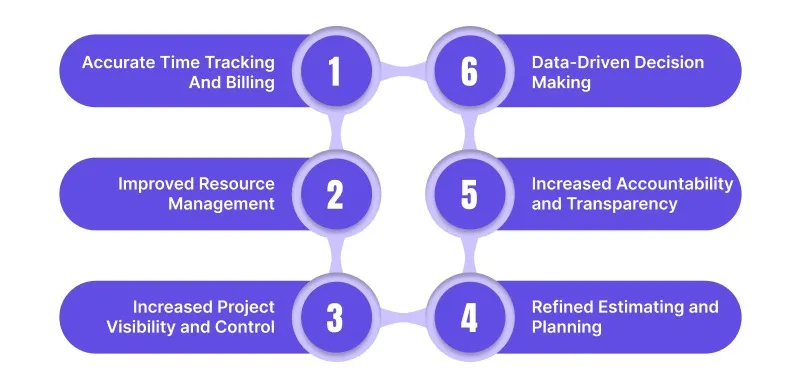
1. Accurate Time Tracking And Billing
A project-based timesheet produces a detailed record of time spent on each project and task; hence, no guessing about client invoicing and billing is made. Using accurate time tracking, you will account for all billable hours and reduce revenue leakage, ultimately positively impacting your profitability.
2. Improved Resource Management
You can discover resource allocation and appropriateness by tracking time across projects and tasks. With this data, you can balance workloads, avoid burnout or leaving workers underutilized, and ensure that the proper resources are put into the right tasks.
3. Increased Project Visibility and Control
Project-based timesheets allow you to track projects’ progression in real-time. You can spot drawbacks or tasks that take more time than expected. With this understanding, you can make appropriate choices between rebalancing resources, extending timelines, or proactively communicating with stakeholders to manage expectations.
4. Refined Estimating and Planning
Clear time tracking on historical project-based timesheets can greatly help develop guidelines for estimating and planning processes when planning new projects. It is possible to analyze the time spent on similar projects or work processes to more precise estimates and plans, hence better budgeting and resource deployment.
5. Increased Accountability and Transparency
The project-based timesheets promote transparency by recording the time spent on each task and job. This transparency will support better team communication, collaboration, trust, and progress reporting to stakeholders.
6. Data-Driven Decision Making
Accurate time-tracking data can be a powerful tool for making informed decisions about project prioritization, resource allocation, and budget management. This data-driven approach enables efficient project management, risk mitigation, and increased profitability.
Project-based timesheets can offer greater control over your projects, better resource management, and a higher project success rate on time and within budget.
Workstatus: A Modern Approach To Project-Based Timesheets
Efficient project management helps businesses gain an edge and grow in the modern competitive world. Nevertheless, conventional task-based timesheets always fail to satisfy, making teams experience tedious data entries, limited view, and unconnected processes.
Introducing Workstatus, a breakthrough system that alters how you handle project timelines and budgets. It provides intelligent automation, insightful reporting, and seamless collaboration options and empowers you to effectively perform the workflow, optimize resource allocation, and enhance project delivery.
1. Flexible Timesheet Filtering and Viewing Options
Workstatus has a set of filters and options to give a detailed and accurate analysis of your project timesheets. You can filter your timesheets by date range, team members, project, and specific tasks/to-dos. This versatility would allow you to easily drill into the data that counts if you wish to check logged hours for a certain team member, see the time spent on a specific project over a given period, or analyze the effort dedicated to individual tasks or deliverables.
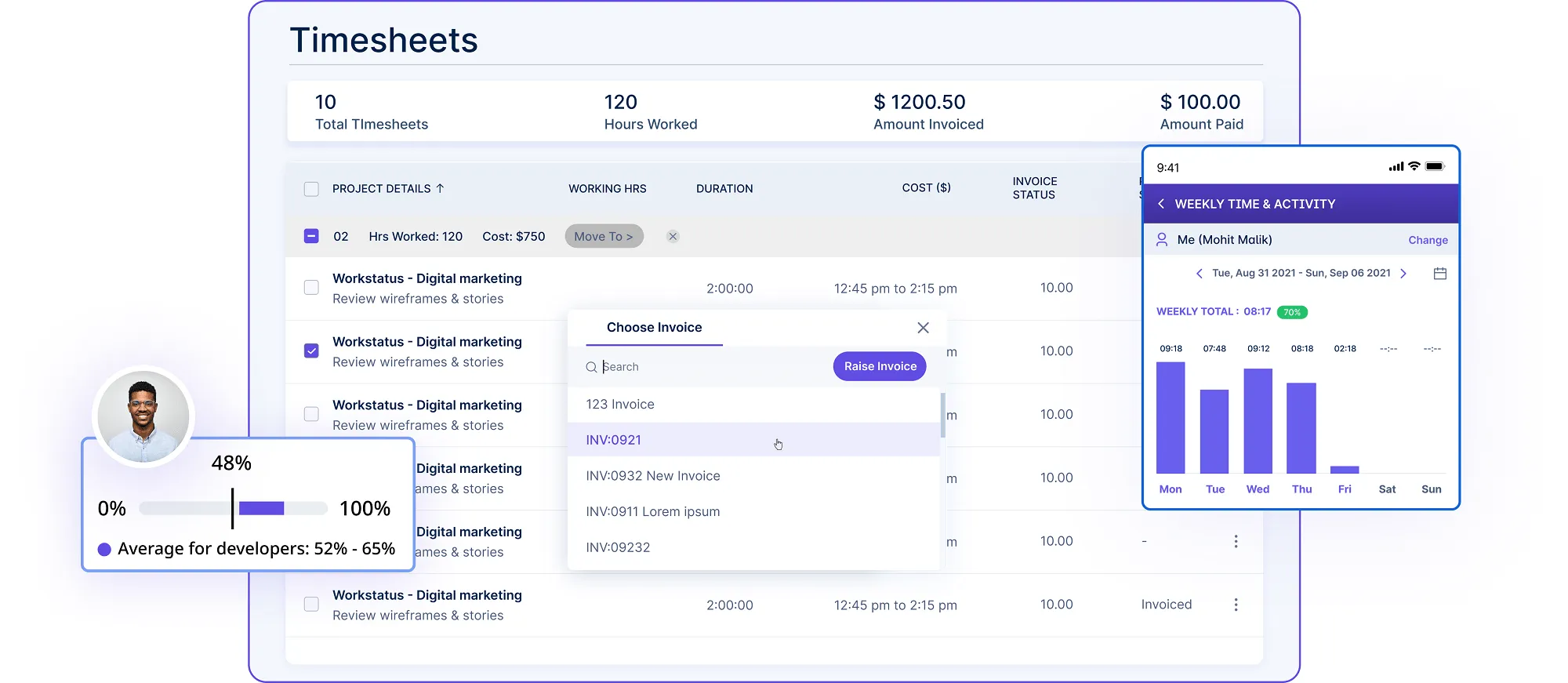
2. Date-wise Timesheet Reporting
Workstatus allows you to generate timesheet reports by date range conveniently. This capability makes it easy to monitor projects and billable hours, thus guaranteeing the accuracy of the invoices. Just choose the period, and Workstatus will generate a detailed report covering when each team member logged in, project by project, and task by task.
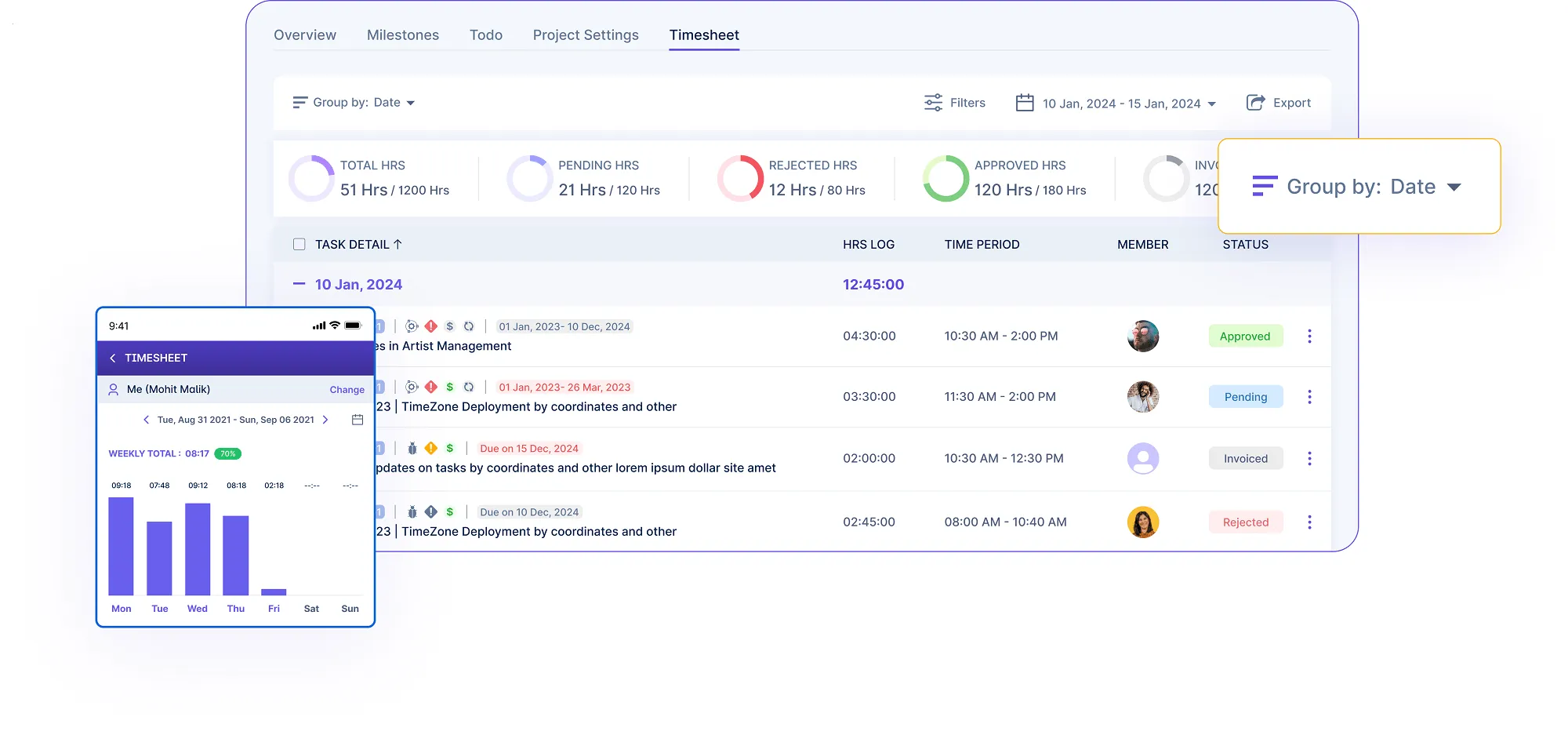
3. Member-wise Timesheet Reporting
Workstatus does all the member-wise timesheet reporting for you to identify individual team member contributions. This feature will enable you to create reports that cover the topics of the individual team members and show them in a neatly summarized form with the projects they were involved in and the time they spent on them. This visibility level helps in effective resource management, workload balancing, and monitoring performance.
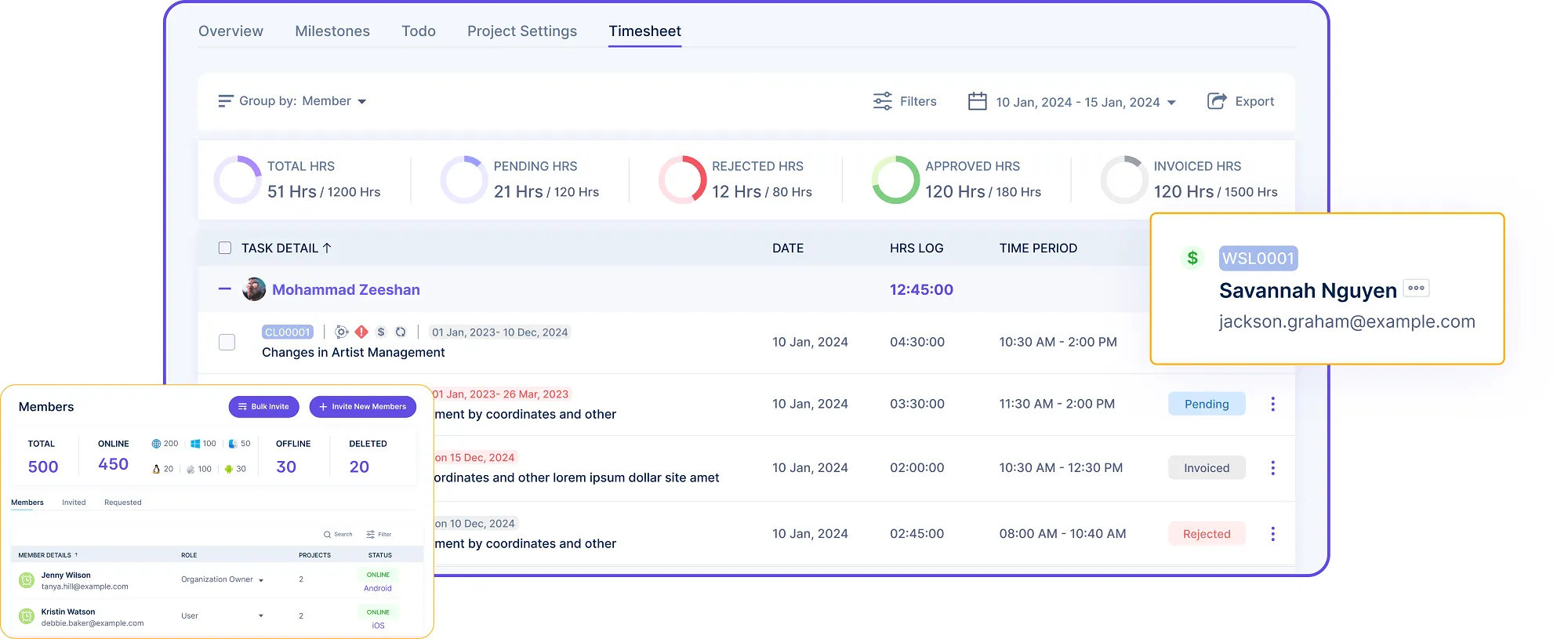
4. To-Do/Task-wise Timesheet Reporting
Besides reporting on the project level, Workstatus can generate individual organizers by tasks or to-dos. This detailed and granular level of tracking enables you to precisely track the time invested in each specific deliverable, identify roadblocks and bottlenecks, and keep the task within the established time and budget frame.
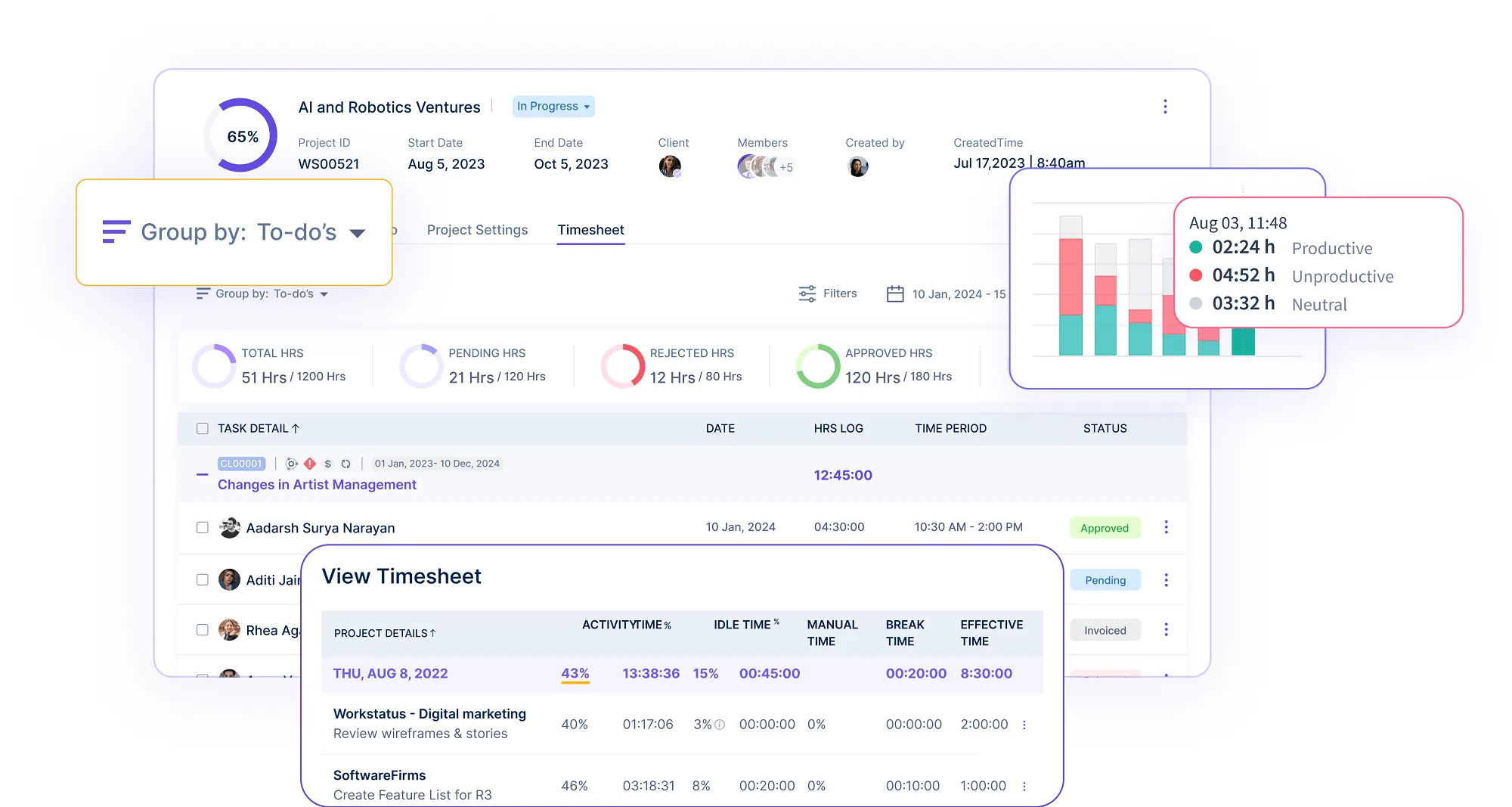
With its modern approach to project-based timesheets, Workstatus significantly contributes to streamlining workflows, optimizing resources, and delivering projects on time and within budget. Experience the future of project management using Workstatus and discover the limitless possibilities for efficiency, cooperation, and project success.
Additional Strategies For Project Management & Success
Here are some additional strategies for project management and business success:
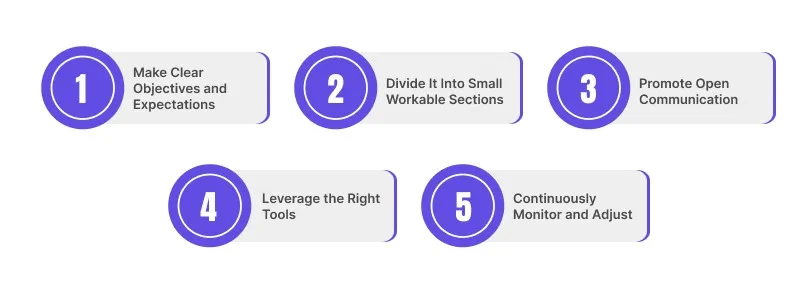
1. Make Clear Objectives and Expectations
Even before starting the work, it is a prerequisite that everyone on the team should be on the same page. Sit with your teammates and stakeholders to determine what the exercise is about. What is the project’s mission? How does one define success? By aligning clear objectives, you make the next steps the most comfortable.
2. Divide It Into Small Workable Sections
It is easy to think that big projects get broken down into small pieces that can be managed individually. The secret? Push the bigger picture into tiny bits of steps and goals. In addition to this, it reduces the workload, increasing your self-confidence, which in turn can be translated into more accomplishment.
3. Promote Open Communication
Effective communication is the substance that glues initiatives together. Facilitate an open culture where team members feel comfortable voicing their doubts, asking questions, and sharing their concerns. Done regularly, standups, team check-ins, and retrospectives can reveal problems early and keep everyone in parallel.
4. Leverage the Right Tools
The right equipment transforms the situation, from project management software to collaboration platforms. Invest in options that decrease stages, raise visibility, and make collaboration easier. Yet, do not forget that the efficiency of the tools is by the people using them, so concentrate on training and adoption.
5. Continuously Monitor and Adjust
Despite having the best-laid plans, things rarely go as you want. That’s why constant tracking of the project’s progress, spotting areas of difficulty, and making adjustments is a must. Don’t be afraid to adjust your strategy and redistribute resources to remain in control.
Successful Use Cases Of Project-Based Timesheets
Here are some successful use cases of project-based timesheets:
1. Marketing Agency Improves Billing Accuracy:
A marketing agency adopted project-based timesheets to track billable hours for client projects accurately. By requiring employees to log their time against specific projects and tasks, the agency could generate more accurate invoices for clients, reducing disputes and ensuring timely payment. This resulted in improved cash flow for the agency and increased client satisfaction.
2. Construction Firm Enhances Project Visibility:
A construction firm implemented project-based timesheets to improve visibility into project progress and costs. By tracking employee time against project tasks and activities, the firm could monitor labor costs, identify inefficiencies, and make data-driven decisions to optimize project performance. As a result, the firm completed projects ahead of schedule and under budget, leading to higher profitability and customer satisfaction.
3. Consulting Firm Streamlines Client Billing:
A consulting firm utilized project-based timesheets to streamline client billing processes and improve revenue recognition. By capturing detailed time entries for client projects, the firm could accurately bill clients for the services rendered, eliminating revenue leakage and maximizing billable hours. This led to improved financial performance and increased profitability for the firm.
Best Practices For Implementing Project-Based Timesheets
Here are some best practices for implementing project-based timesheets:
1. Clear Communication and Training
Make the training sessions on project-based timesheets clear and concise so all the colleagues correctly understand the purpose and use of the timesheets. Expectation and benefit are the real keywords when it comes to successful implementation.
2. Selecting the Right Tool
Choose the project-based timesheet tool that meets your organization’s requirements and is interoperable with the existing project management system. Remember features like user-friendliness, customization options, and performance tracking.
3. Establishing Consistent Processes
Regularize timesheet entrances and due dates to ensure consistency across projects and teams. Ensure all employees in timesheet management know their responsibilities to help reduce confusion.
4. Encouraging Timely and Accurate Entries
Ask team members to submit timesheets in a timely and correct manner. Emphasize the need to document the time spent on each task to obtain correct data: track projects, allocate resources, and manage budget.
5. Regular Monitoring and Feedback
Check timesheet submissions periodically to detect anomalies. Give your team members feedback on their timesheet entries to ensure all inaccuracies or inconsistencies are resolved promptly.
6. Continuous Improvement
Request team members to review and provide feedback about the usability and efficiency of the project-based timesheet system. Apply this feedback regularly to perfect the system and make it more efficient in the business’s operations.
7. Data Analysis and Reporting
Collect data from project-based timesheets to analyze project performance, track progress against goals, and find elements that need improvement. Generate reports and insights segmented from timesheet data to help decision-makers and improve project results.
Closing Thoughts
All in all, project-based timesheets are key instruments for companies that want to monitor their projects and keep the money spent under control. With timely tracking, resource allocation optimization, and budgetary relief, project leaders can make informed decisions and drive project success with project-based time sheets.
By implementing best practices correctly, namely clear communication, consistent processes, and continuous improvement, companies can benefit most from project-based timesheets and effectively organize their project management processes.
Utilizing project-based timesheet information, organizations can optimize project efficiency and minimize risks. Ultimately, this will lead to the achievement of goals. The adoption of project-based timesheets is not only about recording time but also about improving results and confirming project success.
FAQs
Ques: How do project-centered timesheets help improve project visibility and responsibility?
Ans: Project-based timesheets enable the maintain transparent trails of time spent on each task, which helps team members to be more accountable for their time. Managers can always determine who works on what tasks and when encouraging accountability and responsibility among their team members.
Ques: Is it possible for project-oriented timesheets to help in controlling a project budget?Ans: Yes, project-based timesheets, which report and track time spent on particular activities, are indeed very important in estimating all resource spending. These figures enable managers to analyze variances from the planned time, detect early budget overruns, and work effectively to stay within budget limits.
Ques: What is the job of project-based timesheets for resource allocation?
Ans: Project-based timesheets provide evidence of how resources are used across various related activities within a project. Managers can view who does what from the team and reassign workloads to utilize resources more efficiently.












